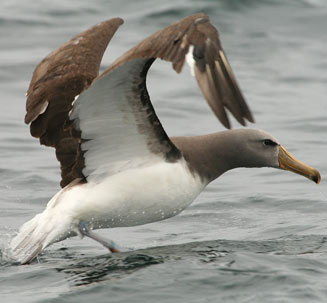|
Thalassarche eremita (Chatham
albatross)
Chathamalbatros [Afrikaans]; Chathammalmok [Afrikaans];
Albatros des Chatham [French]
Life
> Eukaryotes >
Opisthokonta
> Metazoa (animals) >
Bilateria >
Deuterostomia > Chordata >
Craniata > Vertebrata (vertebrates) > Gnathostomata (jawed
vertebrates) > Teleostomi (teleost fish) > Osteichthyes (bony fish) > Class:
Sarcopterygii (lobe-finned
fish) > Stegocephalia (terrestrial
vertebrates) > Tetrapoda
(four-legged vertebrates) > Reptiliomorpha > Amniota >
Reptilia (reptiles) >
Romeriida > Diapsida > Archosauromorpha > Archosauria >
Dinosauria
(dinosaurs) > Saurischia > Theropoda (bipedal predatory dinosaurs) >
Coelurosauria > Maniraptora > Aves
(birds) > Order: Ciconiiformes
> Family: Diomedeidae
 |
|
|
Chatham albatross, offshore from Chile, South
America. [photo Pablo Caceres ©] |
|
Distribution and habitat
Breeds on Pyramid Rock, Chatham Island, east of New
Zealand, after which it rapidly migrates across the South Pacific to spend the
period from April-June off Chile and Peru. There is only one confirmed record of
it in southern African waters, as it was spotted following a fishing vessel
approximately 50km south-west of Cape Point, Western Cape in 2001.
Food
It mainly eats offal, fish, crustaceans and squid, often
following fishing vessels in search of food scraps.
Threats
Critically endangered, with an approximate global
population of just 5300 pairs, largely caused by mortalities on longlines,
habitat degradation from storms and occasional illegal harvesting of chicks.
References
-
Hockey PAR, Dean WRJ and Ryan PG 2005. Roberts
- Birds of southern Africa, VIIth ed. The Trustees of the John Voelcker
Bird Book Fund, Cape Town.
|
